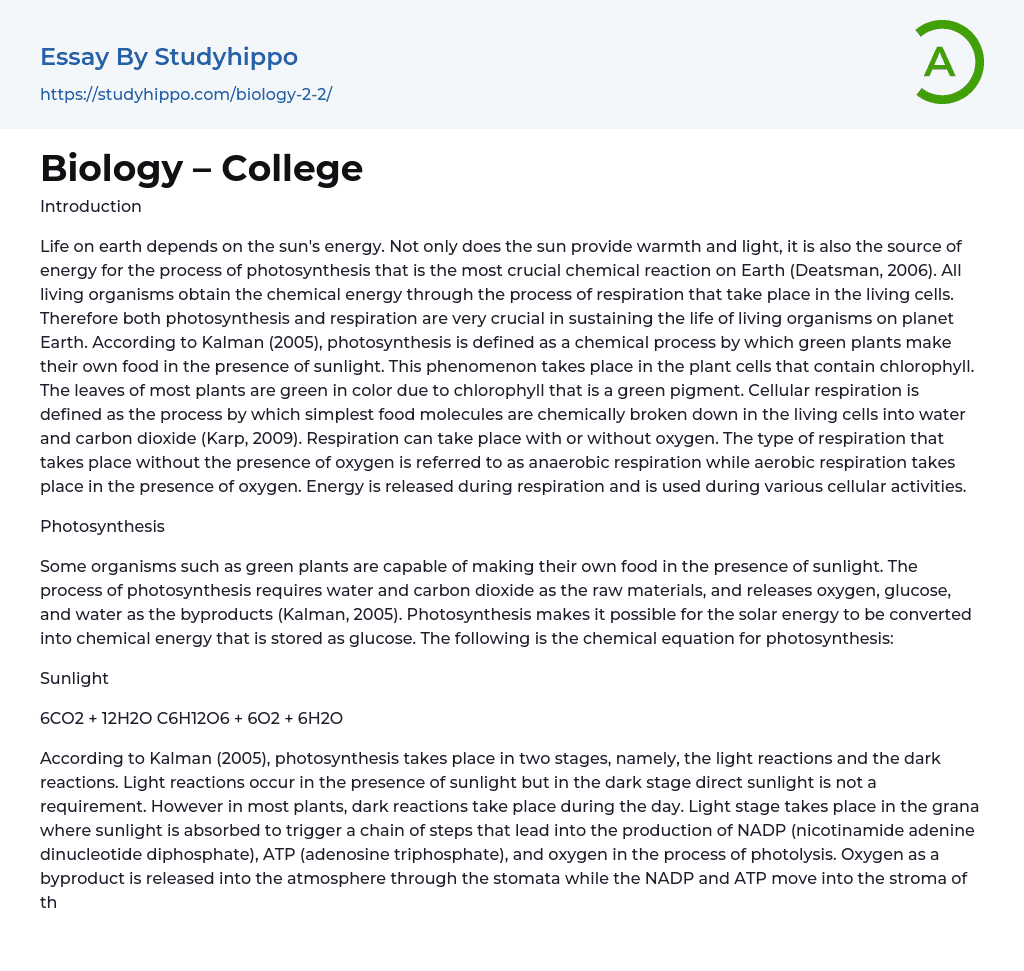The sun's energy is essential for life on Earth, providing warmth, light, and the ability to perform photosynthesis. Photosynthesis is a chemical process that occurs in green plant cells containing chlorophyll. It converts sunlight into food and also gives plants their characteristic green color. In contrast, all organisms obtain chemical energy through respiration, which takes place within living cells and involves breaking down food molecules into water and carbon dioxide. Respiration can occur with or without oxygen, known as aerobic or anaerobic respiration respectively. The energy released during respiration is used for various cellular activities. While some organisms like green plants are capable of producing their own food using sunlight through photosynthesis, this process requires inputs such as water and carbon dioxide while generating outputs including oxygen, glucose, and water. Essentially, it transforms solar ene
...rgy into stored chemical energy in the form of glucose.According to Kalman (2005), the equation for photosynthesis is: Sunlight + 6CO2 + 12H2O -> C6H12O6 + 6O2 + 6H2O. Photosynthesis occurs in two stages: light reactions and dark reactions. Light reactions happen in the grana, where sunlight is absorbed, leading to the production of NADP, ATP, and oxygen through photolysis.
Photosynthesis and aerobic respiration are interconnected processes. During photosynthesis, glucose and oxygen are produced as oxygen is released into the atmosphere through stomata. Meanwhile, NADP and ATP move into the chloroplast's stroma for use in the dark reactions.
The dark reactions take place in the stroma and utilize ATP and NADP to convert carbon dioxide into sugar through carbon fixation. The resulting sugar and released oxygen are then used in aerobic respiration. Aerobic respiration involves breaking down simple sugar molecules with oxygen t
release electrons and generate energy.
Energy produced during aerobic respiration is transported by adenosine triphosphate (ATP) to other cells in the body. In organic cells, this process starts with carbohydrates breaking down into glucose. Glucose then reacts with oxygen in mitochondria to produce carbon dioxide, water, and more energy.
The equation for aerobic respiration is C6H12O6 + 6O2 > 6CO2 + 6H2O + energy (ATP). The stored energy of ATP is released through hydrolysis: ATP + H2O > ADP + Pi ? = 7.2 kcal/molPhotosynthesis provides glucose and oxygen for aerobic respiration in both animal and plant cells. Aerobic respiration produces carbon dioxide, water, and energy in plants and animals. Glycolysis is the process where a glucose molecule breaks down into two pyruvate molecules, occurring in various cells' cytoplasm including plant cells, animal cells, and microorganisms' cells. It involves more than six enzymes. When there is no available oxygen for oxidative phosphorylation to produce ATP through glycolysis, fermentation occurs as an alternative process. Fermentation metabolizes pyruvate to create compounds such as lactic acid, hydrogen, and ethanol. Glycolysis is essential for extracting chemical energy from glucose. The equation for glycolysis discovered in 2001 produces two ATP molecules and NADH: C6H12O6 + 2ADP + 2Pi + 2NAD+ > 2ATP + 2NADH + 2H2O + 2H+ + 2CH3COCOO-. Fermentation allows the release of chemical energy stored in food substrates. Anaerobic organisms utilize sunlight energy through glucose produced by photosynthesis. Enzymes play a crucial role as biological catalysts that accelerate chemical reactions within living cells.The enzymes contain active sites made of proteins where specific interactions with substrates occur. Initially, the substrates attach to the active sites of the enzyme through non-covalent
interactions such as ionic bonds, hydrogen bonds, and hydrophobic interactions. Once bound to the active site, the substrate goes through various mechanisms that enhance the process and convert it into appropriate products. After the reaction is complete, the products are released so that enzymes can accept new substrates. Overall, enzymatic action involves three interactions: substrate acceptance, acceleration of reactions leading to product formation, and subsequent release of those products (Starr et al., 2008).
To meet different physiological needs throughout a cell's life, enzymatic activities in living cells can be regulated through various mechanisms. One mechanism is feedback inhibition where an enzyme's activity is inhibited by its own end product. For example, threonine deaminase converts threonine into isoleucine but is inhibited by isoleucine itself (Karp, 2009). When there is a decrease in concentration of the end product, feedback inhibition becomes inactive and enzymatic action continues. Apart from feedback inhibition, enzyme activities can also be regulated through interactions with other proteins and covalent modifications (Taggart & Starr, 2006).
- Organic Chemistry essays
- Acid essays
- Calcium essays
- Chemical Bond essays
- Chemical Reaction essays
- Chromatography essays
- Ethanol essays
- Hydrogen essays
- Periodic Table essays
- Titration essays
- Chemical reactions essays
- Osmosis essays
- Carbohydrate essays
- Carbon essays
- Ph essays
- Diffusion essays
- Copper essays
- Salt essays
- Concentration essays
- Sodium essays
- Distillation essays
- Amylase essays
- Magnesium essays
- Acid Rain essays
- Agriculture essays
- Albert einstein essays
- Animals essays
- Archaeology essays
- Bear essays
- Biology essays
- Birds essays
- Butterfly essays
- Cat essays
- Charles Darwin essays
- Chemistry essays
- Dinosaur essays
- Discovery essays
- Dolphin essays
- Elephant essays
- Eli Whitney essays
- Environmental Science essays
- Evolution essays
- Fish essays
- Genetics essays
- Horse essays
- Human Evolution essays
- Isaac Newton essays
- Journal essays
- Linguistics essays
- Lion essays




